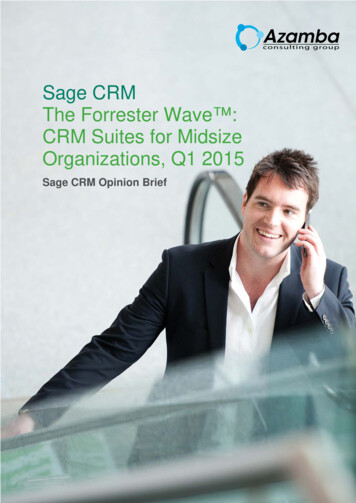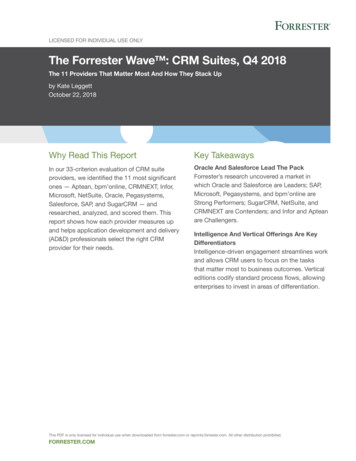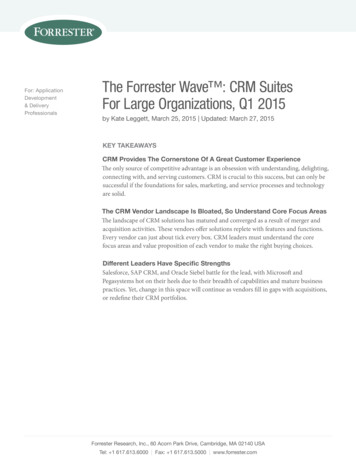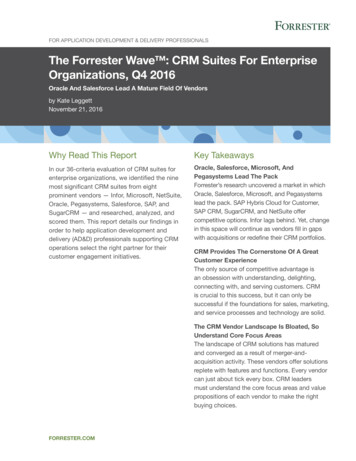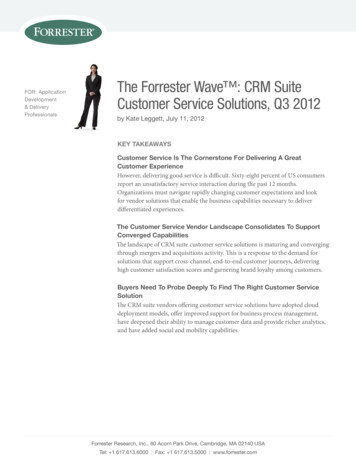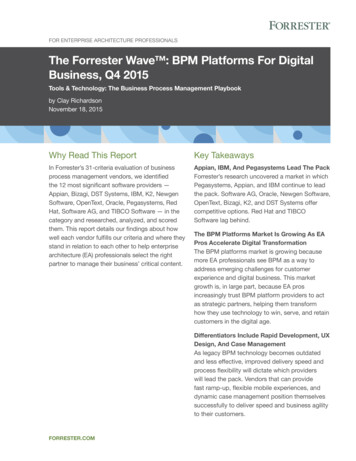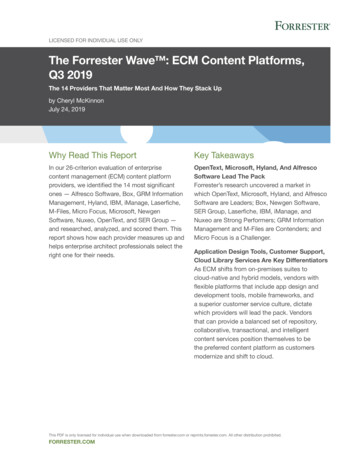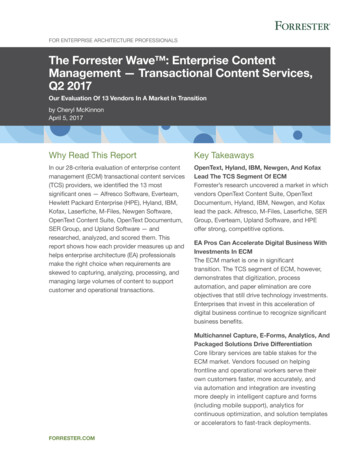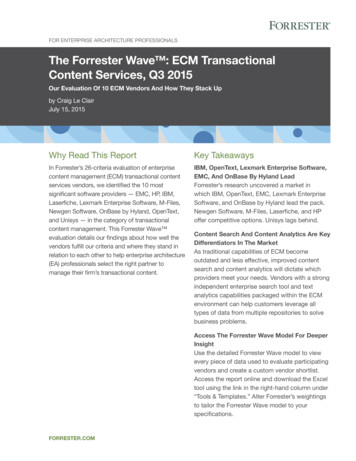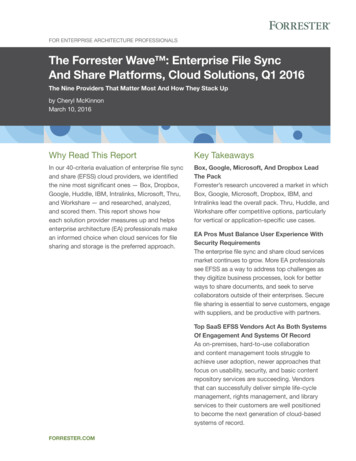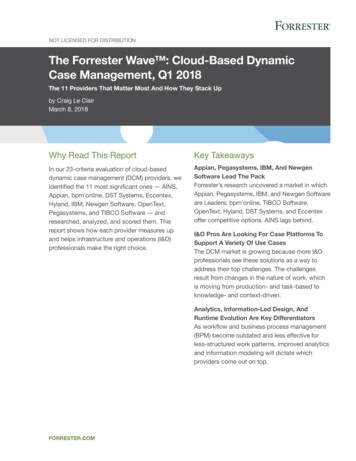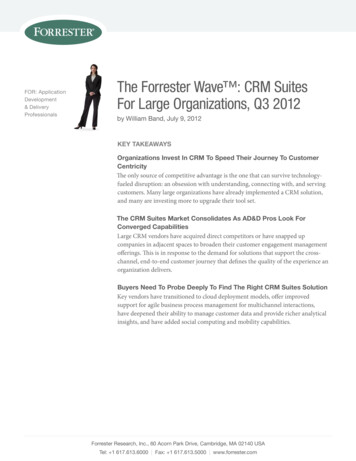
Transcription
FOR: ApplicationDevelopment& DeliveryprofessionalsThe Forrester Wave : CRM SuitesFor Large Organizations, Q3 2012by William Band, July 9, 2012Key TaKeaWaysorganizations invest in CRM To speed Their Journey To CustomerCentricityThe only source of competitive advantage is the one that can survive technologyfueled disruption: an obsession with understanding, connecting with, and servingcustomers. Many large organizations have already implemented a CRM solution,and many are investing more to upgrade their tool set.The CRM suites Market Consolidates as ad&d pros Look ForConverged CapabilitiesLarge CRM vendors have acquired direct competitors or have snapped upcompanies in adjacent spaces to broaden their customer engagement managementofferings. This is in response to the demand for solutions that support the crosschannel, end-to-end customer journey that defines the quality of the experience anorganization delivers.Buyers Need To probe deeply To Find The Right CRM suites solutionKey vendors have transitioned to cloud deployment models, offer improvedsupport for agile business process management for multichannel interactions,have deepened their ability to manage customer data and provide richer analyticalinsights, and have added social computing and mobility capabilities.Forrester Research, Inc., 60 Acorn park Drive, cambridge, mA 02140 UsATel: 1 617.613.6000 Fax: 1 617.613.5000 www.forrester.com
For Application Development & Delivery ProfessionalsJuly 9, 2012The Forrester Wave : CRM Suites For LargeOrganizations, Q3 2012The 17 Solutions That Matter Most And How They Stack Upby William Bandwith Stephen Powers, Kate Leggett, Boris Evelson, Brian K. Walker, Reedwan Iqbal,and Rowan CurranWhy Read This ReportDuring the past five years, the customer relationship management (CRM) solutions market hasexperienced considerable growth and turmoil, including significant vendor consolidation and a rapidrise in the popularity of cloud solutions. In addition, quickly evolving technologies such as multichanneldigital customer engagement, real-time decisioning, social computing, business process management(BPM), and mobility are creating new ways for organizations to deliver differentiated customerexperiences. In this report, we evaluated 17 significant products in the space from a broad range ofvendors: CDC Software, FrontRange Solutions, Maximizer Software, Microsoft, NetSuite, Oracle (lookingat its Oracle CRM On Demand, Oracle E-Business Suite CRM, Oracle PeopleSoft Enterprise CRM, andOracle Siebel CRM products), Pegasystems, RightNow Technologies (now Oracle RightNow CX CloudService), Sage CRM, Sage SalesLogix, salesforce.com, SAP CRM, SugarCRM, and Sword Ciboodle. Thisreport details our findings on how CRM suite solutions for large organizations measure up and plotswhere they stand in relation to each other in order to help application development and delivery (AD&D)professionals select the right solution for their needs.Table Of ContentsNotes & Resources2 Enterprises Struggle To Compete In The AgeOf The CustomerForrester conducted vendor surveyevaluations in February 2012 and evaluated17 CRM solutions worthy of consideration bylarge organizations. We also surveyed vendorcustomers.5 Consider Four Vendor Types7 CRM Suites For Large OrganizationsEvaluation Overview10 The Results: Buyers Should Do Deep DueDiligence To Find The Right Fit14 Vendor Profiles22 Supplemental MaterialRelated Research DocumentsAssess CRM Capabilities To PinpointOpportunitiesJune 20, 2012Define The Right CRM MetricsApril 10, 2012Navigate The Future Of CRMFebruary 16, 2012 2012, Forrester Research, Inc. All rights reserved. Unauthorized reproduction is strictly prohibited. Information is based on best availableresources. Opinions reflect judgment at the time and are subject to change. Forrester , Technographics , Forrester Wave, RoleView, TechRadar,and Total Economic Impact are trademarks of Forrester Research, Inc. All other trademarks are the property of their respective companies. Topurchase reprints of this document, please email clientsupport@forrester.com. For additional information, go to www.forrester.com.
For Application Development & Delivery Professionals2The Forrester Wave : CRM Suites For Large Organizations, Q3 2012ENTERPRISES STRUGGLE TO COMPETE IN THE AGE OF THE CUSTOMERWe’ve entered a new era that Forrester calls the age of the customer. While companies have always,to a greater or lesser extent, called themselves “customer-centric,” this is different. This is not aboutcustomer-centric thinking or taking the attitude that the customer is always right. Instead, the newpower of customers means that a focus on the customer now matters more than any other strategicimperative.1 Competitive differentiation achieved through brand, manufacturing, distribution, andIT are all now only table stakes. The only source of competitive advantage is the one that can survivetechnology-fueled disruption — an obsession with understanding, delighting, connecting with, andserving customers. Effectively managing your company’s relationships with those who buy and useyour company’s products and services has never been more important.Organizations Of All Sizes Continue To Invest In CRM SolutionsForrester defines customer relationship management (CRM) as:The business processes and supporting technologies that support the key activities of: targeting,acquiring, retaining, understanding, and collaborating with customers.2Although Forrester does not advocate that organizations view CRM only as a set of technologies,strong interest in investing in and deploying technology solutions to improve customer-facing businessprocesses continues. In fact, 50% of the 556 North America and European large organizations that werecently surveyed have already implemented a CRM solution (a marketing, sales, or customer serviceapplication) — and many are investing more to upgrade their tool set. An additional 23% have plans toadopt a CRM solution within the next 12 to 24 months. This pattern of widespread adoption for CRMsolutions is evident among midsize organizations as well (see Figure 1).Despite CRM adoption rates, as organizations strive to succeed in the age of the customer, businessand IT professionals responsible for customer-facing processes struggle with how to define CRMstrategies, re-engineer customer-facing business processes, acquire and deploy the appropriatesupporting technologies, and lead and sustain the organizational changes required to make thetransition to new ways of working. To make savvy CRM solution investment decisions, you mustunderstand and navigate a number of important trends:3 Customer experience management moves beyond aspiration to strategy. Moreorganizations are moving to define clear and actionable customer experience strategies that:1) define the intended experience; 2) direct employee activities and decision-making; and 3)guide funding decisions and project prioritization.4 Increasingly, organizations are embracingcustomer experience management as a management discipline.5 Brands embrace the experience ecosystem. Firms need to move to break free from theirorganizational silos, invest in understanding customer moments of truth through journeymapping, and embrace the concept of the customer experience ecosystem — which considers theinfluence of every single employee and external partner on every single customer interaction.6 2012, Forrester Research, Inc. Reproduction ProhibitedJuly 9, 2012
For Application Development & Delivery Professionals3The Forrester Wave : CRM Suites For Large Organizations, Q3 2012 Solutions converge to support cross-channel customer interactions. Forrester anticipatesthe convergence of technologies from varied sectors to form the core of customer experiencemanagement (CXM) solutions. Vendors from a diverse set of solution categories — fromeCommerce platforms to content management, site search, personalization, and customerservice — are expanding their capabilities to support the management and optimization ofcross-touchpoint customer experiences.7 Organizations strive to domesticate untamed processes. More organizations are focusingon renovating poorly managed customer-facing processes, which remain, in many ways, thelast frontiers of business process automation.8 Processes that touch customers and sufferfrom inefficiency and disconnects include: customer onboarding, order administration, loanprocessing, incident management, customer service, and investigations. As a result, solutionswith a strong BPM backbone are attracting increased attention from organizations seeking tobetter manage fragmented customer interaction processes. Mobile applications empower customer-facing workers and consumers. Interest in mobileCRM solutions is red hot. Organizations have invested for more than a decade in traditionalCRM solutions. However, mobile workers often still do not have the necessary informationat hand to sell to and serve customers effectively when they are away from the office. Newermobile device form factors (smartphones and tablets) have become ubiquitous, openingup new possibilities for improving employee productivity and interactions with customers.Virtually all CRM vendors now offer mobile solutions as extensions of their applications to fillthis gap. But despite the growing maturity of mobile CRM solutions, business and IT leadersare still perplexed by the complexities of the different mobile options and architectures.9 Organizations use social customer engagement tactics more widely. More social CRM usecases spotlighting demonstrable business value are emerging. Forrester’s annual GroundswellAwards showcase hundreds examples of how organizations use social computing — for example,in market research, marketing communication, customer self-service, and product development.10 Big data moves to center stage. Application development and business intelligence professionalsface the challenge that social-sourced customer intelligence can become a never-ending datagusher. As result, organizations are showing growing interest in big data. This emergingparadigm focuses on architecting analytic and transactional applications to harness petabytes ofcomplex information flowing in from social media and other new and traditional sources.11 Agile implementation approaches take root. Companies want to become more flexiblein their approach to managing interactions with customers. As result, they are increasinglyadopting Agile project management and software development methodologies based on theprinciples of iterative development, where requirements evolve through collaboration within aself-organizing, cross-functional team. This desire for increased flexibility and agility has beena key driver of the rapid adoption of CRM software-as-a-service (SaaS) solutions.12 2012, Forrester Research, Inc. Reproduction ProhibitedJuly 9, 2012
For Application Development & Delivery Professionals4The Forrester Wave : CRM Suites For Large Organizations, Q3 2012 The voice of the customer (VoC) becomes an engine for cultural change. Organizationsincreasingly try to harness the voice of the customer to prioritize process improvementsand help back-office employees better understand customer expectations. Providing morecustomer feedback to employees across the organization in the form of survey results,customer visits, social sentiment data, and the like assists employees in gaining a betterunderstanding of the impact of their decisions on the customer.13Figure 1 Half Of Surveyed Large Organizations Have Already Adopted A CRM Solution“What are your firm’s plans to adopt the following packaged (not custom) business applications?”(Customer relationship sted but no plansEnterprise(1,000 or moreemployees)SMB(20 to 999employees)*Implemented,not expandingNot interestedPlanning to implementin the next 12 monthsDon’t knowPlanning to implementin a year or more25%25%12%21%20%15%15%10%8%19%12%3%14%Base: 556 IT executives and technology decision-makers at enterprise organizations*Base: 536 IT executives and technology decision-makers at SMB organizations(percentages may not total 100 because of rounding)Source: Forrsights Software Survey, Q4 2011Source: Forrester Research, Inc.61645Consolidation Sweeps Through The CRM MarketIn recent years, there has been continued consolidation and turmoil in the CRM solutions landscape.Some of these changes include: Oracle has bulked up. In early 2011, Oracle acquired ATG, an eCommerce platform, and in mid2011 it snapped up InQuira, a leading knowledge management solution. It also acquired theintellectual property assets of Market2Lead, a provider of demand generation and marketingautomation software, to be beef up its Oracle CRM On Demand offering. In early 2012, Oracleacquired Endeca, a leading provider of unstructured data management, web commerce, andbusiness intelligence solutions, as well as RightNow Technologies, a cloud CRM vendor thatemphasizes customer experience and contact center technology. It rebranded RightNow as OracleRightNow CX Cloud Service. SAP has made notable acquisitions. In late 2010, SAP acquired mobility platform solutionsprovider Sybase. In 2011, it entered into a partnership with eGain for knowledge managementand also acquired SuccessFactors, a SaaS-based human capital management company. Inearly 2012, SAP made a move into social media analysis with a partnership with NetBase. It 2012, Forrester Research, Inc. Reproduction ProhibitedJuly 9, 2012
For Application Development & Delivery Professionals5The Forrester Wave : CRM Suites For Large Organizations, Q3 2012also acquired Syclo to accelerate its push into mobility, including efforts behind mobile assetmanagement and field service solutions. Salesforce.com has turned on its acquisition engine. During 2010 and 2011, salesforce.commade a series of moves, acquiring: 1) the Ruby development software company Heroku; 2)Radian6, a social media monitoring and engagement platform; 3) Dimdim, a collaborationvendor; 4) Model Metrics, a cloud services consulting company; 5) Rypple, a human capitalmanagement (HCM) solution; 6) Assist.ly, a customer support and help desk company for thesmall business market; and 7) Stypi, a collaborative authoring tool.14 Specialty vendors are also making acquisition moves. Other acquisitions of note includeNice Systems’ acquisition of enterprise feedback monitoring (EFM) vendor Fizzback andVerint’s acquisition of EFM vendor Vovici. Additionally, Marketo, a marketing automationsolutions vendor, acquired Crowd Factory, a social campaign management platform.Consider Four Vendor TypesEven with consolidation, CRM solutions fall into four groups to choose from, although the distinctionsbetween these categories have become less pronounced over the past three years (see Figure 2): CRM suites for large organizations. CRM vendors focused on large organizations —organizations with 1,000 or more employees — typically offer a full range of functionality. Theycan scale to serve large user populations, and they offer support for multiple languages andcountries. They offer their products primarily through the traditional on-premises licensingmodel, but many now also offer hosted and SaaS deployment options. Vendors in this categoryalso target midsize organizations, offering prepackaged versions of their solutions (with morelimited functionality and fixed-price implementation services) with more-affordable price tags. CRM suites for midmarket organizations. Vendors primarily target these solutions atorganizations or divisions of larger enterprises with 250 to 999 employees. They often havemore-limited capabilities in specific areas and are simpler to use than solutions built for theenterprise market. These solutions are less suitable for large-scale global deployments. Like thevendors targeting large organizations, the vendors in this group offer a variety of deploymentoptions, including on-premises licensed, hosted, and SaaS. Some vendors in this categoryhave upgraded their solutions to be more suitable to enterprise-class buyers and are gainingacceptance in that segment as well. CRM solutions for small organizations. Vendors with solutions in this category primarilytarget organizations with up to 250 employees. They offer a variety of deployment options,including on-premises licensed and SaaS. Functionality is limited compared with what fullCRM suite solutions offer and typically focuses on basic contact management (including socialchannel interactions) and email marketing capabilities for individuals or small teams. 2012, Forrester Research, Inc. Reproduction ProhibitedJuly 9, 2012
For Application Development & Delivery Professionals6The Forrester Wave : CRM Suites For Large Organizations, Q3 2012 CRM specialty tools. This category comprises vendors that offer solutions with narrowfunctional breadth but deep specialty capabilities — such as marketing automation andcustomer service — for both large and midmarket organizations. This category also includesCRM vendors that specialize in specific industries such as financial services, life sciences,telecommunications, and not-for-profit.Figure 2 CRM Solutions Fit Into Four CategoriesExamples of enterprise CRM suitesExamples of CRM specialty solutionsCRM suites primarily designed for firms with1,000 employees or more Microsoft Dynamics CRM* Oracle CRM On Demand* Oracle E-Business Suite CRM Oracle PeopleSoft Enterprise CRM Oracle Siebel CRM Pega CRM RightNow CX* salesforce.com* SAP CRM* Sword CiboodleCustomer service solutions: Astute Solutions Customer Service Software Consona Customer Service CRM eGain Software Genesys CIM Platform Software Kana Service Experience Management Parature Customer Service Software Spaces by MoxieExamples of midmarket CRM suitesCRM suites primarily designed for firms with250 to 999 employees CDC Software Pivotal CRM FrontRange Solutions’ GoldMine EnterpriseEdition Maximizer CRM Microsoft Dynamics CRM* NetSuite Oracle CRM On Demand* RightNow CX* SageCRM Sage SalesLogix salesforce.com* SAP Business All-in-One CRM Sugar EnterpriseExamples of marketing automation solutions: Aprimo Marketing Studio Infor Epiphany Marketing Neolane Campaign SAS Customer Intelligence Platform IBM Unica SuiteExamples of industry specialist solutions: Amdocs CES Customer Management(telecommunications) Blackbaud (not-for-profits) Cegedim Dendrite (life sciences) NexJ Systems (financial services) StayinFront (life sciences) Update (life sciences) Veeva (life sciences)Examples of CRM solutionsfor small organizations Act Capsule GoldMine InfusionSoft Nimble Zoho*These vendors have a significant base of both enterprise and midmarket customers.61643 2012, Forrester Research, Inc. Reproduction ProhibitedSource: Forrester Research, Inc.July 9, 2012
For Application Development & Delivery Professionals7The Forrester Wave : CRM Suites For Large Organizations, Q3 2012CRM SUITES FOR LARGE ORGANIZATIONS EVALUATION OVERVIEWForrester evaluated the strengths and weaknesses of top CRM vendors suitable to meeting theneeds of large and midsize organizations across 414 criteria. We then applied two sets of criteriaweightings: one appropriate for large, enterprise-class organizations and another reflecting thepriorities of midsize organizations. The following assessment will help you see how the 17 CRMsuite products that we evaluated for large organizations compare.Buyers Focus On Current Offering, Future Vision, And Strength Of Installed BaseAfter examining past research, user need assessments, and vendor and expert interviews, wedeveloped a comprehensive set of evaluation criteria. We evaluated vendors against 414 criteria,which we grouped into three high-level categories: Current offering. We looked at the breadth of vendors’ product offering(s), global capabilities,and ada
navigate The Future Of cRm February 16, 2012 The Forrester Wave : CRM suites For Large organizations, Q3 2012 The 17 solutions That matter most And How They stack Up by William Band with stephen powers, Kate leggett, Boris Evelson, Brian K. Walker, Re
